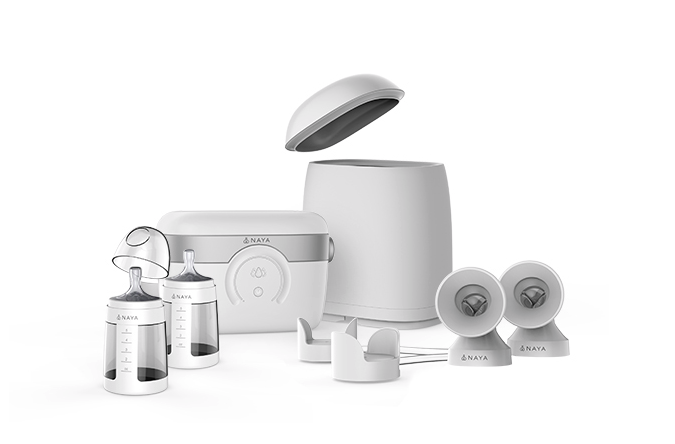Smart health products have been around for some time targeting health and well-being, with a reasonable number aimed at our aging populations who may be unable to care for themselves as once before. It stands to reason that the other spectrum of the lifecycle is being monitored and analyzed the data made possible through connected devices.
A smart baby summit is now part of the CES experience offering parents and parents-to-be with health, welfare and educational information and experiences for their children. Here are some of the most interesting devices on offer.
Bloomlife smart patch
The Bloomlife smart patch is the first consumer-accessible clinically validated pregnancy wearable to automatically track contractions by safely and passively picking up electrical signals from the uterus, unlocking information for consumers previously only available at a doctor’s visit.
Users can visualize each contraction as it occurs and learn how it corresponds to the sensations felt. Bloomlife calculates the frequency and duration and changes in contractions so women can more easily communicate with their birth team.
In support of its mission to improve birth outcomes, and in partnership with the Bloomlife community of moms, Bloomlife intends to crowdsource the largest and most comprehensive data set on maternal and fetal health parameters to identify biomarkers for pregnancy complications.
“Despite one in eight women delivering preterm, the underlying causes and triggers of preterm birth are poorly understood,” says Eric Dy, co-founder and CEO of Bloomlife. “Traditional approaches to clinical research are fraught with red tape when it comes to pregnancy. We see an opportunity to revolutionize medical discovery and innovation, leveraging the power of citizen science and crowdsourced consumer-generated data, which is particularly needed in underserved areas such as pregnancy.”
Cost: $149 per month, presumably relying on some expectation of when you will give birth
Smart Pump by Naya Health
When a breast pump is designed by a couple skilled in biology and robotics, you know it’s going to be something innovative. The FDA cleared, hospital-grade Smart pump is a lightweight three pounds, designed to pump milk faster with an app that automatically tracks the amount of milk expressed and enables Moms to keep track of their milk inventory. Once the Mom no longer needs it, they can return it to the store and the company will refurbish it and donate it to a mother who would otherwise not have access to a breast pump.
Cost: $999
SNOO smart sleeper
SNOO is a baby bed — as distinct from a cradle — that uses smart technology to boost sleep, by choosing slow rocking and calming white noise, and to calm crying, by choosing just the right mix of faster rocking and stronger womb sound. It includes a “5-second swaddle” that keeps babies safely on their back making it impossible for them to roll onto their stomach. A corresponding app helps parents understand their baby’s crying cues and get a real-time view of what SNOO is doing to comfort their baby.
Cost: $1,160.00
Hatch Baby Changing Pad and scale
The smart changing pad is designed to help parents determine how much weight their baby has gained. An accompanying app tracks your baby’s weight, diaper habits, feeding, and sleeping. The app seems to be the star of the product, as the changing pad is simply a padded scale. The company has a range of future products coming out this year; it will be interesting to see how smart they get.
Cost: $250
Tytohome
TytoHome is a connected health system that provides a complete telehealth visit and comprehensive medical exam of the heart, lungs, ears, skin, throat and temperature through the use of an advanced digital stethoscope, otoscope, thermometer and examination camera with a secure data exchange, clinical repository, appropriate instructions and live telehealth visits. The company has recently announced a partnership with American Well, making online health care accessible, though the health provider reimbursements may vary from state to state.
The benefit of the product is that it could be used by different members of the family (assuming it is appropriately sterilized between uses) making it more cost effective. However, I wonder how quickly it will be usurped by a more sophisticated model, leaving early adopters wanting. The company also offers a product for health professionals, enabling them to offer clinical services to remote locations when needed such as schools, nursing, and home care facilities, this could prove more successful.
Cost: $250
But is all this really needed?
The inevitable question from reviewing a plethora of baby connected devices is whether they are really necessary. It’s easy to imagine generations of mothers commenting that they managed fine without such devices. But for babies with complex needs or parents with brains addled by sleep deprivation, surely the option to purchase such items is a positive one? After all, the market appears to be well regulated and monitored with plenty of parents offering their opinions of different products through blogs and review sites. The life of each product will be the question, as baby devices are traditionally stored for future offspring or passed onto friends or neighbors, will this also be the case with connected products?
Ultimately we choose what we consume and what we bypass. This market might never get as big as the devices for the aged, but it is growing.






















